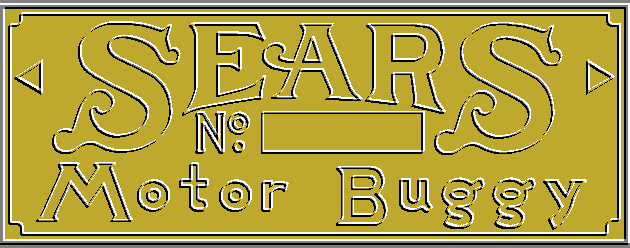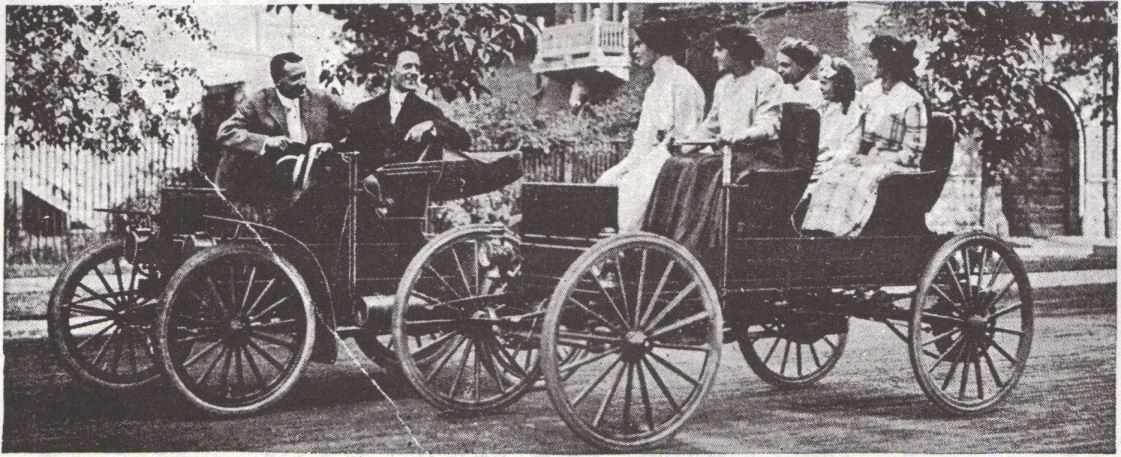
A Brief History of Sears
|
|
|
This is an advertisement for a Sears from the 1909 Fall Catalogue Click on the picture to see the full size. |
In 1893, the company incorporated itself as Sears, Roebuck and Company with the intent of offering its products by mail order to rural customers at prices lower than could be found in general stores. In 1896, the first Sears, Roebuck and Co. catalogue was published offering a wide variety of products to its mail order customers.
Through the years, the Sears-Roebuck catalogue was the source of products ranging from clothing to toys to household items (including the house itself!). The fall 1909 catalogue included, for the first time, an automobile: The Sears Motor Buggy.
After Richard Sears retired as company president in 1908, new Sears President Robert E. Wood was persuaded by associates to get into the automobile craze and take advantage of this new trend. The company approached Alvaro S. Krotz, who had built an electric car under his own name in Ohio from 1903 - 1904, to design and produce a car. CLICK HERE to read more about Alvaro S. Krotz.
The initial run of Sears Motor Buggies were built in the Hercules Buggy plant in Evansville, Indiana. But by late 1909, the Sears Motor Car Works factory at the intersection of Harrison and Loomis streets in Chicago was ready, and operations commenced from there. The October 6th, 1909 issue of The Horseless Age (Volume 24, Number 14) says:
"Sears, Roebuck & Co., Chicago, Ill., are employing about fifty men in assembling their motor buggy."
It is then stated in the Dec 29th, 1909 issue (Volume 24, Number 26) that:
"Sears, Roebuck & Co., Chicago, Ill., have leased from the Grand Central Market Company a large building at the corner of Loomis and Harrison streets, erected two years ago for market purposes. The Sears-Roebuck firm will use the building for manufacturing automobiles. The dimensions are 140x476 feet, and the lease runs for a number of years at an annual rental of $14,000."
I believe it is around this time that production was moved from the Hercules Buggy Works in Evansville, IN to the Chicago Plant.
About the Sears Motor Buggy
The earliest mention I have been able to find of the Sears in trade journals of the time is in the January 1st, 1909 issue (Volume 13, Number 7 - Page 184) of the Cycle and Automobile trade Journal. This is a small minor article that describes the Sears and says that "Sears, Roebuck & Co., of Chicago, ILL., one of the largest mail order houses in the country, have lately taken up the sale of automobiles..." Click here to see the article.
Sears catalogue number 118 appeared in the spring (April) of 1909. The index in the front cover of this catalogue has a category of "Motor Buggies" of which it says "Ask for our Special Motor Buggy Circular. This is the only automobile specific literature issued by Sears in 1909, other than the ad in the fall catalogue. Click Here to see the Special Motorbuggy Circular.
In catalogue 119 which appeared in the fall (October) of 1909, a full page advertisement appeared showing a so-called Motor Buggy costing $395.00 as shown, with top, fenders, and steps. It's catalogue number was "21R 333". If a buyer did not want a top and fenders, catalogue number "21R 444" was available for $370.00. Neither model had any other letter designation associated with it. Trying to make the "21R 444" into a different vehicle, it is described as a "Sears Motor Buggy Runabout". No other Model numbers where offered by Sears in 1909. Click here to see this ad.
The spring 1910 general catalogue number 120 had a four page section in full color describing the "Five new attractive models for 1910" (G,H, J, K & L). This statement could be interpreted in two ways: 1 - of course they sold new cars each year, or 2 - the five new cars were entirely different than 1909, though only three of the 5 were entirely new. The equivalent of the Model G and Model H were built in 1909, but did not use the letter designations.
Sears advertised that the Sears Motor Buggy was, "more than just a buggy with a motor." It was designed as an automobile with an angle-iron frame, four full elliptical springs, and Timken Roller bearings for each wheel.
Sears advertisements indicate that they had been building cars since 1906, but this does not appear to be true. Mr. Krotz, the designer, finished the plans for his first highwheeler in 1906, but it was not finished until September of 1907, over a year before signing the contract with Sears. About a dozen or more prototypes were built in 1908 before the contract was signed. Sears may have acquired some of these prototypes so that they could say that a ”Sears had been running since 1907”. This is known as “literary license”.
The engine was a 10 HP (increased to 14 HP in 1910), 2-cylinder opposed, air-cooled motor built by the Reeves Company or. Power was transmitted to the rear wheels via a friction transmission and double chain drive. This combination resulted in a top speed of around 25 MPH. EDITORS NOTE: In reality, there were at least three enginesused in the Sears over the years and the manufacuters are difficult to determine. There is information that supports that one engine was the Reeves Model. Others show the engine coming from the Hydraulic Engineering Workes of Chicago. See information on both in the Unclassified" section of the Sears Photo Archive.
The Sears rode high on 36 X 13/8 inch solid rubber tires on a wheelbase of 72 inches (87 inches for the 4 passenger Model P and the Truck models). The Sears could also be bought with 38 X 2 inch Cushion rubber tires and 34 X 3 inch Pneumatic tires.
Several color combinations were offered including Carmen Red and Black and Brewster Green and Black.
Price for the Sears ranged from $325 for the bare bones Model G to $495 for the Model L that included such amenities as fenders, a top, running boards, and pneumatic tires.
The Sears could be picked up in Chicago or delivered by rail to your closest railroad depot. All that a new owner needed to do was uncrate it, do some minor assembly, add fuel and oil and drive it home.

|
|
A picture of some happy Sear customers out for a drive in their Sears. Click on the picture to see the full size. |
Customers Praise the Sears Motor Buggy
The End of the Sears
Sources
Standard Catalog of American Car since 1805 - 1942 3rd addition - Copyright 1996 by Krause Publications.
Antique Automobile Magazine - Fall 1956 Issue, article by Don McCray entitled "Alvaro S. Krotz and the Sears Motor Buggy".
Cycle and Automobile trade Journal - Volume 14, Number 7 from January 1st, 1909, Page 184.
The Horseless Age - Volume 24, Number 14 from October 6th, 1909, Volume 24 Number 14, Page 387 - Minor Mention Section.
The Horseless Age - Volume 24, Number 26 from December 29th, 1909, Volume 24 Number 26, Page 805.
How to contact me... |

|
|
John M. Daly |
||
| Phone: | (815) 786-4824 | |
| Email: | ||